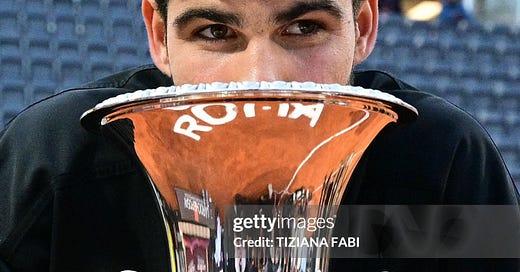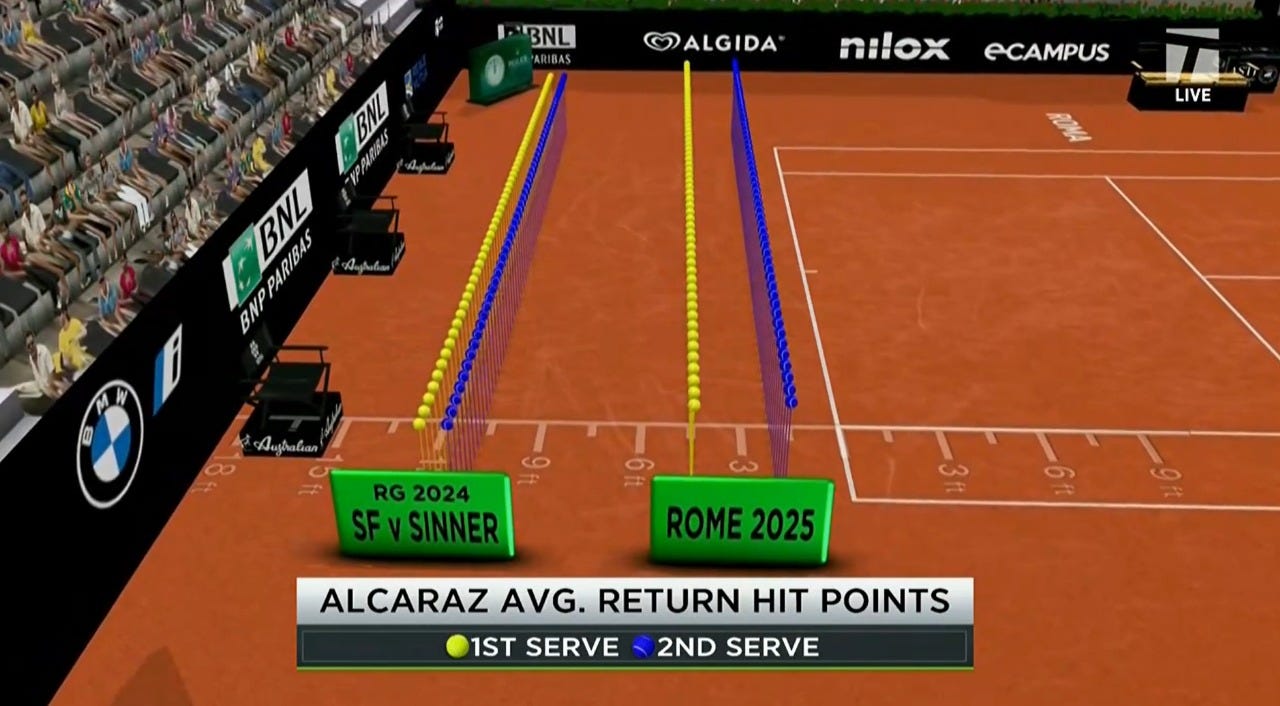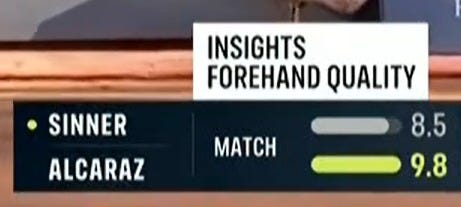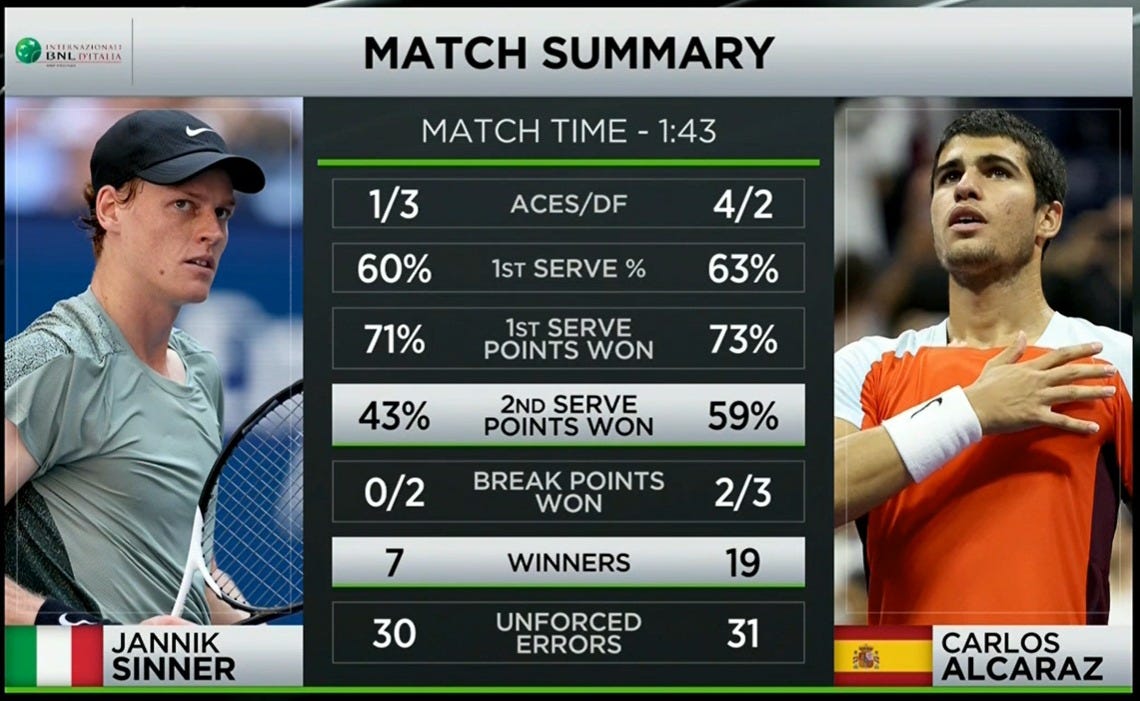Game. Set. Match. Alcaraz.
He did it again.
For the fourth consecutive time, Sinner has entered a match against Alcaraz as the best player in the world—and for the fourth consecutive time, he has walked away defeated, left wondering what needs to change.
And although this wasn’t one of their better matches—far from it, in fact—when Alcaraz and Sinner play, the world watches. For a year now, the world has watched Sinner go on an all-time great streak, yet remain unable to solve the Carlitos puzzle.
Perhaps the most surprising thing, to both Sinner and me, is that this is a matchup he actually used to have as much success in as anyone before this legendary run. Now, even with everything he’s achieved, that edge has vanished.
So, what really changed? I have a theory.
Sinner was always an aggressive baseliner—relying on overpowering his opponents, taking away time, missing occasionally, but never afraid to hit heavy, explosive strokes for, no offence, a player of his frame.
Then, almost two years ago, something shifted: he stopped missing.
The result? The best player in the world.
The downfall? In prioritizing consistency, dialing things back to 90% power for more control, I think he’s lost the biggest edge he had over Alcaraz: time.
Now, don’t get me wrong—Sinner is still probably the cleanest ball-striker on tour, with heavy shots off both wings. But at this level, we're talking milliseconds. And when your rival is an all-time great, milliseconds matter.
Close your eyes. Visualize Sinner’s best moments against Alcaraz since 2023.
The first set at Indian Wells. The first set at Roland Garros.
You see a Sinner out-hitting Alcaraz, rattling him by not missing—not rushing him the way he used to.
Then again, this is just my theory. I haven’t done the research yet to validate or refute it.
As for the Rome final, it was probably the most tactically sound match I’ve seen Alcaraz play against Sinner.
He didn’t come out trying to bash winners. Instead, he patiently set up heavy forehands to Sinner’s forehand—a strategy that’s proving really effective against him on these slower surfaces. He mixed in his trademark drop shots, too, but the MVP today was undoubtedly his backhand.
If you read my preview, I had two major questions about Carlos:
How would he approach returning serve?
Would his new-look backhand hold up against Jannik?
To start the match, he stuck with what he had done throughout the tournament—camping on the baseline for returns.
But he was quick to adjust—shifting back to the return position he used at Roland Garros last year. That change allowed him to get far more returns in play than just about anyone has managed against Sinner this week.
All in all, the first set didn’t have many standout moments. Both players were feeling each other out, playing with a bit of nervous energy.
One thing that did stand out for both, though, was the forehand.
So, why did I still think the backhand was the key today, even though it ended with a -9 differential? Because it did exactly what it needed to: it kept Carlos from having to go for broke on the forehand.
It held its own in cross-court exchanges, changed direction when it mattered most, and provided enough stability and resistance that the forehand was never forced into desperation mode. It gave Alcaraz’s fearhand a chance, and really, that’s all it needs.
To Sinner’s credit, he kept the scoreboard pressure on Carlos throughout the first set, and it nearly paid off in the twelfth game, when he earned two set points.
In my opinion, Sinner made a crucial error on that second set point—going for a backhand down the line when he didn’t really need to. That moment felt like the turning point. From there, the match was effectively over.
Alcaraz won the first set with the point of the match, and with Sinner’s legs fading—and nothing to show for seventy minutes of topsy-turvy, grueling tennis—he tapped out.
Too good an opponent, too soon into this comeback. As expected.
The second set was a blank canvas, and Carlos painted on it however he wanted.
As a fan, it was mesmerizing to watch him enter that “flow state”—a zone where, honestly, I don’t think anyone can stay with him.
And just like that, that was all she wrote.
7–6, 6–1 — Carlos Alcaraz, your Rome champion.
And something tells me… this won’t be his last title here.
Now, let’s hope both players recover well in time for Roland Garros—and give us the final everyone’s dreaming of.
Vamos and Forza!









Told you Jannik coming back to the tour would do Carlos some good ;)
Zain, are you from India?